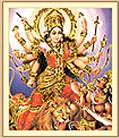| |
The
onset of Aso, the final month of the Hindu year, witnesses the lion's
share of festivals judiciously crammed into 30 days! The bright half,
Shukla Paksh, sets off with Navaratri for 9 days and nights, celebrated
especially by women. Dushera follows on the 10th and Sharad Poonam on
the 15th, the night on which Lord Krishna played Raas with the Gopis
of Vrundavan. The dark half, Vad Paksh, witnesses the festivities reaching
a feverish pitch in the ongoing battle of righteousness over evil; with
Dhanteras on the 13th, Kali Chaudash on the 14th and the final day of
the year crowned by Diwali. Every year this festival commences on the
1st day of Aso till the 9th . Devotees celebrate the victory of Lord's
shakti-power, over evil. There are several names attached to this shakti,
such as Amba, Ambica, Bhavani, Chamunda and Durga.
Origin
Having pleased Brahma, the evil Mahishasur obtained a boon that
he should never die by human hands. He then wrought carnage in the three
worlds, thus worrying the three 'devatas' - Brahma, Vishnu and Shiva.
They prayed to the Lord for succor. This resulted in the manifestation
of Durga. To vanquish Mahishasur, Indra gifted her his weapon, known
as 'Vajra'. Vishnu gave the 'Chakra' - spinning disc and Shiva, the
'Trishul' - trident. By creating 18 arms, Durga fought for 9 days with
Mahishasur, using the above weapons and many others. On the 10th day,
she attained 'Vijay' - victory. Thus the 10th day is known as 'Vijaya
Dashmi.' A second reference, of how Mahishasur was vanquished, appears
in the Skand Purana. Once he visited Mount Arunachal. Here his eyes
fell on Parvati performing austerities. Attracted to her, he assumed
the guise of an old man and questioned her about the purpose of her
austerities. "To please the powerful Lord Shiva and marry him," she
replied. Mahishasur proffered," I am also powerful. Marry me instead."
This affront on Lord Shiva induced Parvati to challenge the demon to
a duel. A terrific battle ensued. Ultimately, being the Lord's Shakti,
Parvati slew him.
Sentiments
Perspectively, the 'chitta-vrutti' of our indriyas is likened to
Mahish - a bull, without reigns or control. Therefore this 'Vrutti'
can only be subjugated using the Lord's shakti. The Lord's shakti prevails
in humans, in the form of 'buddhi', faith, and strength and valor. However,
the Lord's grace and this shakti, fail to manifest without self-discipline
and control.
Ritual
After puja of Shakti-Mataji's clay murti on the 10th day, devotees
to take the murti to a water body. Here they sing kirtans and performe
sattvic folk-dances while chanting mantras. Then they submerge the murti,
similar to Ganeshji's on Jal Zilani Ekadashi. People in every town and
village celebrate this festival, performing sattvic Raas and Garba.
Import
(1) The most poignant import of Navaratri is to please Shakti-Mataji
by self-abnegation and 'tapas' - austerity. Just as Parvati performed
austerities for 80,000 years to please Shiva, women fast for 9 days
in their own way. Some have only one meal a day, others only milk or
fruit. From this self-control, known as 'sanyam', springs shakti-power
which pleases Mataji. However, instead of the sattvic Raas and Garba,
people dance to rajasic forms such as: disco, rap, rock and so forth.
This pollutes and incites the indriyas, rather than controlling them.
Therefore, instead of remaining aloof from the sense pleasures to preserve
one's shakti, people freak out and lose it! To preserve the sattvic
nature and sanctity of Navaratri, Pramukh Swami Maharaj exhorts devotees
everywhere to organise the Navaratri Garbas in the auspices of a mandir
or satsang centre in which the male-female 'maryada' (discipline) is
maintained. This is preferable than attending expensive, high profile
parties staged by commercial entrepreneurs, where the indriyas run riot,
hence dissipating shakti. And so now people often quip that Navaratri
has become 'Loveratri'!
(2) After marriage, a man becomes a 'Pati' - husband, and a woman, 'Patni'
- wife. However, when the 'Pati' becomes a 'Pita' - father, and the
'Patni', a 'Mata' - mother, the Hindu Dharma upgrades them to the level
of deities -'devatulya':
"Pitru devo bhava, Matru devo bhava."
Poignant words are used by the scriptures in the above sutras: 'Pitru'
is used instead of balak (child), kishore (teenager) or yuvak (youth)
and "Matru" instead of balika, kishori or yuvati. For females then,
the emphasis is to imbibe attributes of a true Mata, as exemplified
by the Shakti-deity, and so become devatulya. Therefore during Navaratri
Shakti is offered worship precisely to earn her grace and so perpetuate
a sacred tradition rather than desecrate it. For this, the father /
mother has to vanquish evil instincts or thoughts which may have crept
into the heart during the past year. This increases one's shakti.
In turn, this endeavor is boosted by Shakti-Mataji, who vanquishes the
evil elements within and showers her grace on devotees who have offered
pure worship.
|
|



